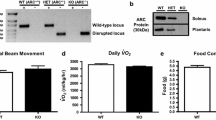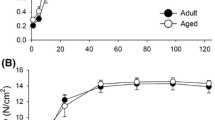Abstract
Age-related muscle atrophy is characterized by decreases in muscle mass and is thought be mediated, at least in part, by increases in myocyte apoptosis. Recent data has demonstrated that the degree of muscle loss with aging may differ between males and females while other work has suggested that apoptosis as indicated by DNA fragmentation may be regulated differently in fast- and slow-twitch muscles. Herein, we investigate how aging affects the regulation of muscle apoptosis in the fast-twitch extensor digitorum longus (EDL) and slow-twitch soleus muscles of young (6-month), aged (26-month), and very aged (30-month) female Fischer 344/NNiaHSD × Brown Norway/BiNia (F344BN) rats. Tissue sections were stained with hydroethidium for ROS and protein extract was subjected to immunoblotting for assessing apoptotic markers. Our data suggest that decreases in muscle mass were associated with increased DNA fragmentation (TUNEL positive) and increases in reactive oxygen species (ROS) as determined by hydroethidium staining in both the EDL and soleus. Similar to our previous work using aged male animals, we observed that the time course and magnitude of changes in Bax, Bcl-2, caspase-3, caspase-9, and cleavage of α-fodrin protein were regulated differently between muscles. These data suggest that aging in the female F344BN rat is associated with decreases in muscle mass, elevations in ROS level, increased muscle cell DNA fragmentation, and alterations in cell membrane integrity and that apoptotic mechanisms may differ between fiber types.









Similar content being viewed by others
References
Lipman RD, Chrisp CE, Hazzard DG, Bronson RT (1996) Pathologic characterization of brown Norway, brown Norway x Fischer 344, and Fischer 344 x brown Norway rats with relation to age. J Gerontol A Biol Sci Med Sci 51(1):B54–59
Rice KM, Linderman JK, Kinnard RS, Blough ER (2005) The Fischer 344/NNiaHSd X Brown Norway/BiNia is a better model of sarcopenia than the Fischer 344/NNiaHSd: a comparative analysis of muscle mass and contractile properties in aging male rat models. Biogerontology 6(5):335–343
Paturi S, Gutta AK, Katta A et al (2010) Effects of aging and gender on muscle mass and regulation of Akt-mTOR-p70s6k related signaling in the F344BN rat model. Mech Ageing Dev 131(3):202–209
Fried LP (2000) Epidemiology of aging. Epidemiol Rev 22(1):95–106
Doherty TJ (2001) The influence of aging and sex on skeletal muscle mass and strength. Curr Opin Clin Nutr Metab Care 4(6):503–508
Janssen I, Heymsfield SB, Wang ZM, Ross R (2000) Skeletal muscle mass and distribution in 468 men and women aged 18-88 yr. J Appl Physiol 89(1):81–88
Lauretani F, Russo CR, Bandinelli S et al (2003) Age-associated changes in skeletal muscles and their effect on mobility: an operational diagnosis of sarcopenia. J Appl Physiol 95(5):1851–1860
Lexell J (1995) Human aging, muscle mass, and fiber type composition. J Gerontol A Biol Sci Med Sci.;50 Spec No:11–16.
Dirks A, Leeuwenburgh C (2002) Apoptosis in skeletal muscle with aging. Am J Physiol Regul Integr Comp Physiol 282(2):R519–527
Whitman SA, Wacker MJ, Richmond SR, Godard MP (2005) Contributions of the ubiquitin-proteasome pathway and apoptosis to human skeletal muscle wasting with age. Pflugers Arch 450(6):437–446
Paturi S, Gutta AK, Kakarla SK et al (2010) Impaired overload-induced hypertrophy in obese Zucker rat slow-twitch skeletal muscle. J Appl Physiol 108(1):7–13
Marzetti E, Leeuwenburgh C (2006) Skeletal muscle apoptosis, sarcopenia and frailty at old age. Exp Gerontol 41(12):1234–1238
Pistilli EE, Jackson JR, Alway SE (2006) Death receptor-associated pro-apoptotic signaling in aged skeletal muscle. Apoptosis: Int J Programmed Cell Death 11(12):2115–2126
Rice KM, Blough ER (2006) Sarcopenia-related apoptosis is regulated differently in fast- and slow-twitch muscles of the aging F344/N x BN rat model. Mech Ageing Dev 127(8):670–679
Blough ER, Linderman JK (2000) Lack of skeletal muscle hypertrophy in very aged male Fischer 344 x Brown Norway rats. J Appl Physiol 88(4):1265–1270
Kinnard RS, Mylabathula DB, Uddemarri S, Rice KM, Wright GL, Blough ER (2005) Regulation of p70(S6k), GSK-3beta, and calcineurin in rat striated muscle during aging. Biogerontology 6(3):173–184
Degens H, Alway SE (2003) Skeletal muscle function and hypertrophy are diminished in old age. Muscle Nerve 27(3):339–347
Wu M, Desai DH, Kakarla SK et al (2009) Acetaminophen prevents aging-associated hyperglycemia in aged rats: effect of aging-associated hyperactivation of p38-MAPK and ERK1/2. Diabetes Metab Res Rev 25(3):279–286
Lushaj EB, Johnson JK, McKenzie D, Aiken JM (2008) Sarcopenia accelerates at advanced ages in Fisher 344xBrown Norway rats. J Gerontol A Biol Sci Med Sci 63(9):921–927
Marzetti E, Wohlgemuth SE, Lees HA, Chung HY, Giovannini S, Leeuwenburgh C (2008) Age-related activation of mitochondrial caspase-independent apoptotic signaling in rat gastrocnemius muscle. Mech Ageing Dev 129(9):542–549
Alway SE, Degens H, Krishnamurthy G, Chaudhrai A (2003) Denervation stimulates apoptosis but not Id2 expression in hindlimb muscles of aged rats. J Gerontol A Biol Sci Med Sci 58(8):687–697
Alway SE, Degens H, Krishnamurthy G, Smith CA (2002) Potential role for Id myogenic repressors in apoptosis and attenuation of hypertrophy in muscles of aged rats. Am J Physiol Cell Physiol 283(1):C66–76
Dirks AJ, Leeuwenburgh C (2004) Aging and lifelong calorie restriction result in adaptations of skeletal muscle apoptosis repressor, apoptosis-inducing factor, X-linked inhibitor of apoptosis, caspase-3, and caspase-12. Free Radic Biol Med 36(1):27–39
Mishra OP, Randis T, Ashraf QM, Delivoria-Papadopoulos M (2006) Hypoxia-induced Bax and Bcl-2 protein expression, caspase-9 activation, DNA fragmentation, and lipid peroxidation in mitochondria of the cerebral cortex of newborn piglets: the role of nitric oxide. Neuroscience 141(3):1339–1349
Dirks AJ, Leeuwenburgh C (2005) The role of apoptosis in age-related skeletal muscle atrophy. Sports Med 35(6):473–483
Scorrano L, Korsmeyer SJ (2003) Mechanisms of cytochrome c release by proapoptotic BCL-2 family members. Biochem Biophys Res Commun 304(3):437–444
Oltvai ZN, Milliman CL, Korsmeyer SJ (1993) Bcl-2 heterodimerizes in vivo with a conserved homolog, Bax, that accelerates programmed cell death. Cell 74(4):609–619
Gundersen K, Bruusgaard JC (2008) Nuclear domains during muscle atrophy: nuclei lost or paradigm lost? J Physiol 586(Pt 11):2675–2681
Bartoli M, Richard I (2005) Calpains in muscle wasting. Int J Biochem Cell Biol 37(10):2115–2133
von Wnuck LK, Keul P, Lucke S et al (2006) Degraded collagen induces calpain-mediated apoptosis and destruction of the X-chromosome-linked inhibitor of apoptosis (xIAP) in human vascular smooth muscle cells. Cardiovasc Res 69(3):697–705
Winkelmann JC, Forget BG (1993) Erythroid and nonerythroid spectrins. Blood 81(12):3173–3185
Zhou D, Ursitti JA, Bloch RJ (1998) Developmental expression of spectrins in rat skeletal muscle. Mol Biol Cell 9(1):47–61
Srivastava D, Yu S (2006) Stretching to meet needs: integrin-linked kinase and the cardiac pump. Genes Dev 20(17):2327–2331
Repasky EA, Granger BL, Lazarides E (1982) Widespread occurrence of avian spectrin in nonerythroid cells. Cell 29(3):821–833
Craig SW, Pardo JV (1983) Gamma actin, spectrin, and intermediate filament proteins colocalize with vinculin at costameres, myofibril-to-sarcolemma attachment sites. Cell Motility 3(5–6):449–462
Pardo JV, Siliciano JD, Craig SW (1983) A vinculin-containing cortical lattice in skeletal muscle: transverse lattice elements ("costameres") mark sites of attachment between myofibrils and sarcolemma. Proc Natl Acad Sci U S A 80(4):1008–1012
Janicke RU, Ng P, Sprengart ML, Porter AG (1998) Caspase-3 is required for alpha-fodrin cleavage but dispensable for cleavage of other death substrates in apoptosis. J Biol Chem 273(25):15540–15545
Vanags DM, Porn-Ares MI, Coppola S, Burgess DH, Orrenius S (1996) Protease involvement in fodrin cleavage and phosphatidylserine exposure in apoptosis. J Biol Chem 271(49):31075–31085
Garcia-Pelagio KP, Bloch RJ, Ortega A, Gonzalez-Serratos H (2011) Biomechanics of the sarcolemma and costameres in single skeletal muscle fibers from normal and dystrophin-null mice. J Muscle Res Cell Motil 31(5–6):323–336
Lapidos KA, Kakkar R, McNally EM (2004) The dystrophin glycoprotein complex: signaling strength and integrity for the sarcolemma. Circ Res 94(8):1023–1031
Danialou G, Comtois AS, Dudley R et al (2001) Dystrophin-deficient cardiomyocytes are abnormally vulnerable to mechanical stress-induced contractile failure and injury. FASEB J 15(9):1655–1657
Acknowledgments
This study was supported by DOE funding no. DE-SC0005162 to E.R.B.
Author information
Authors and Affiliations
Corresponding author
About this article
Cite this article
Rice, K.M., Manne, N.D.P.K., Gadde, M.K. et al. Differential regulation of apoptosis in slow and fast twitch muscles of aged female F344BN rats. AGE 37, 30 (2015). https://doi.org/10.1007/s11357-015-9767-z
Received:
Accepted:
Published:
DOI: https://doi.org/10.1007/s11357-015-9767-z




